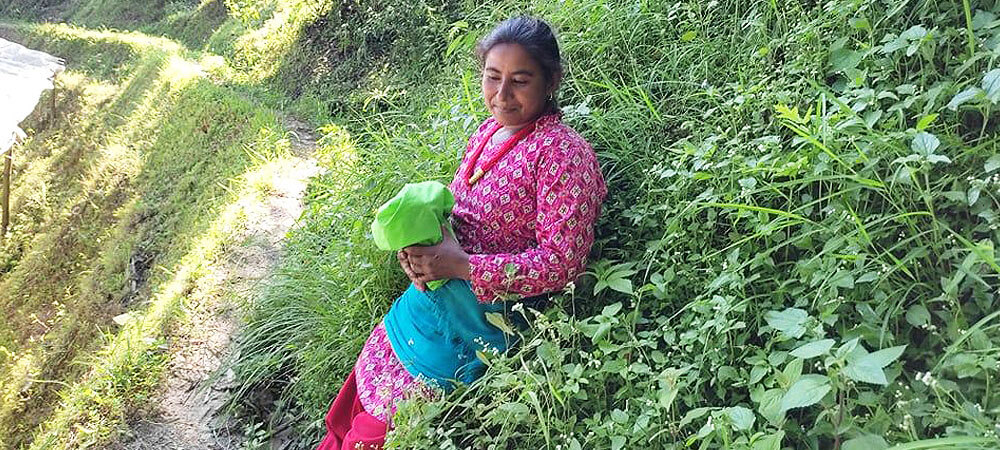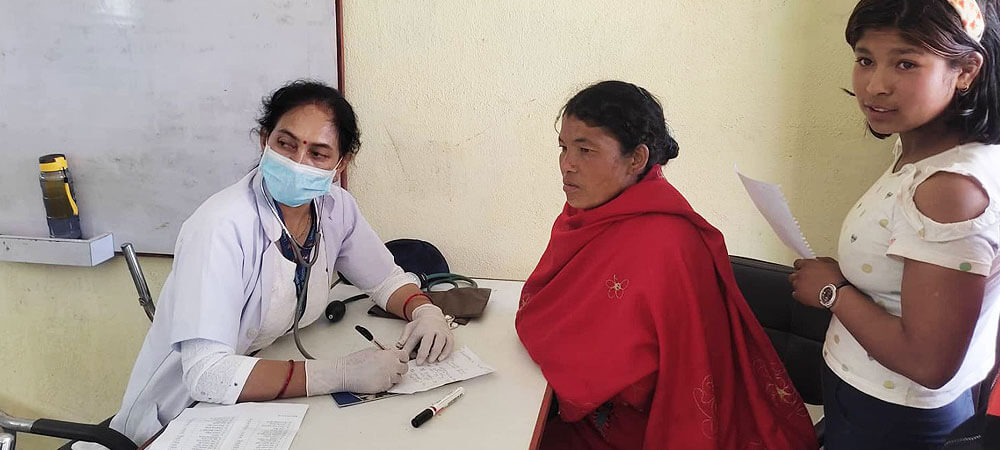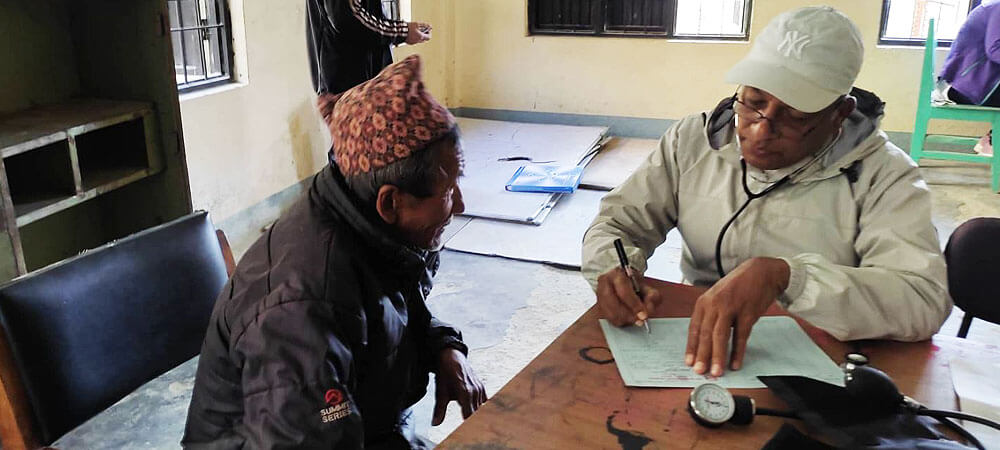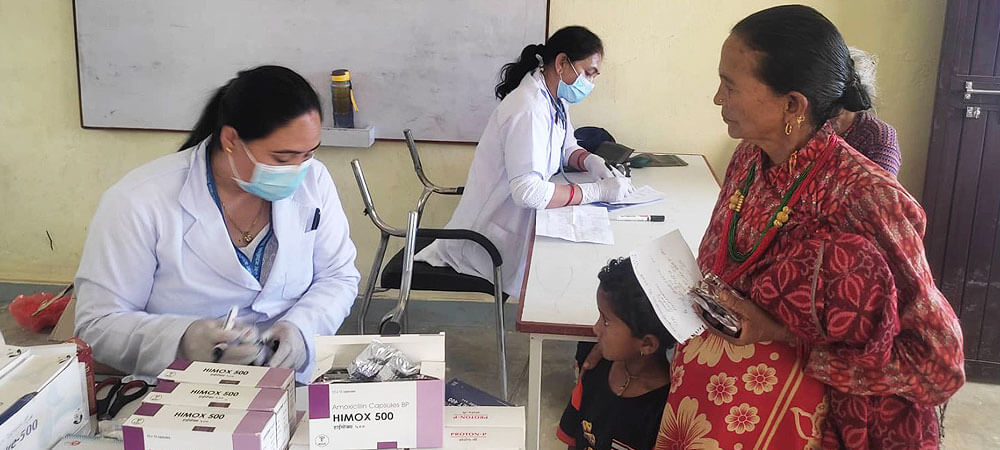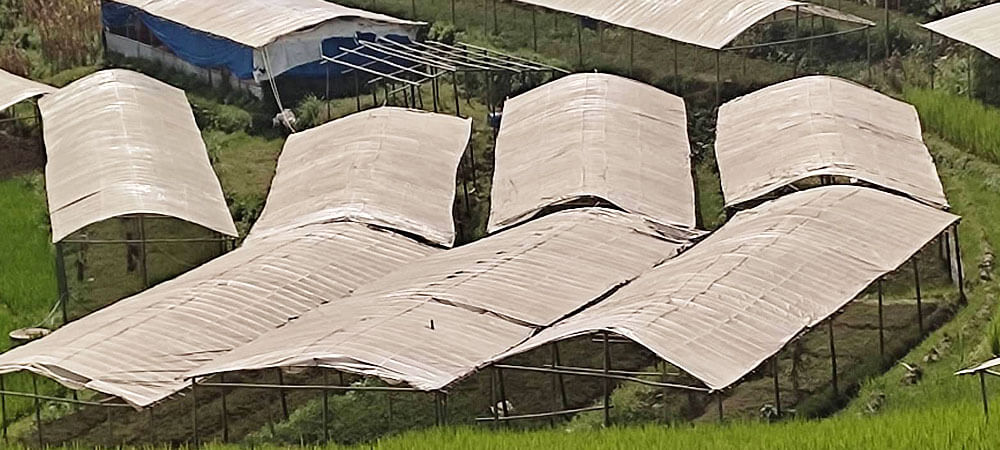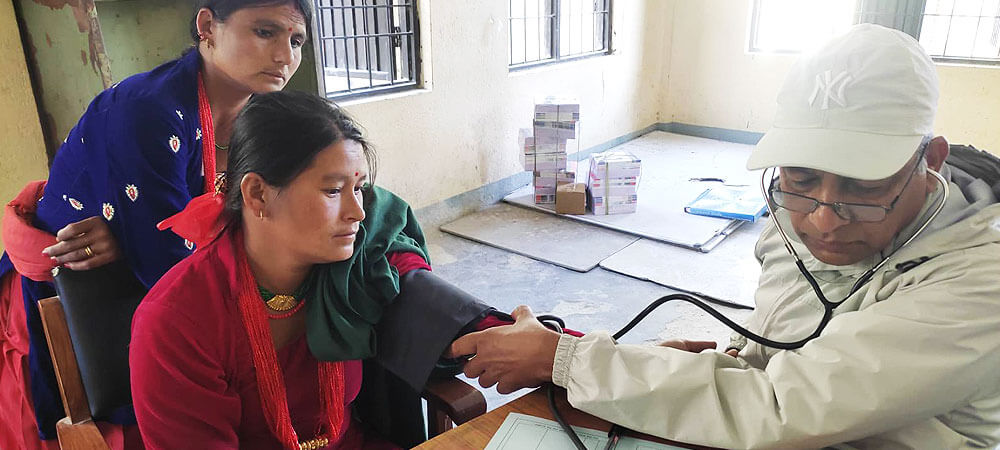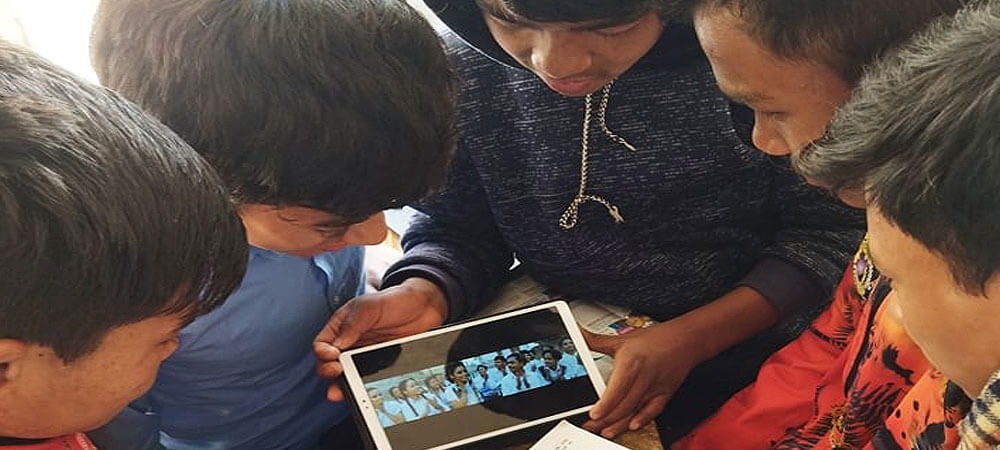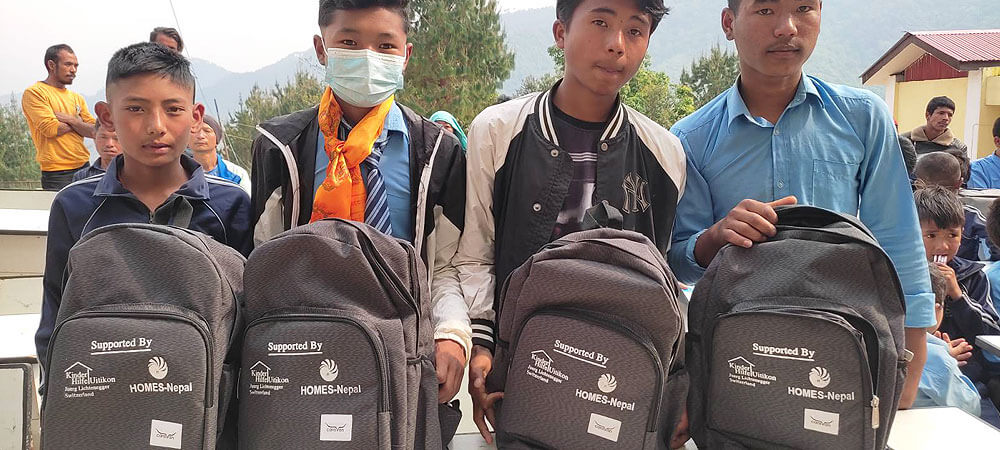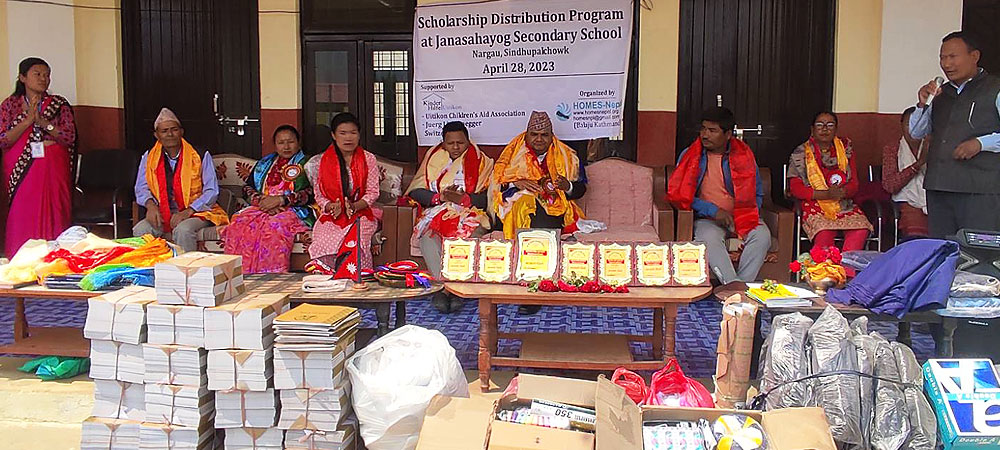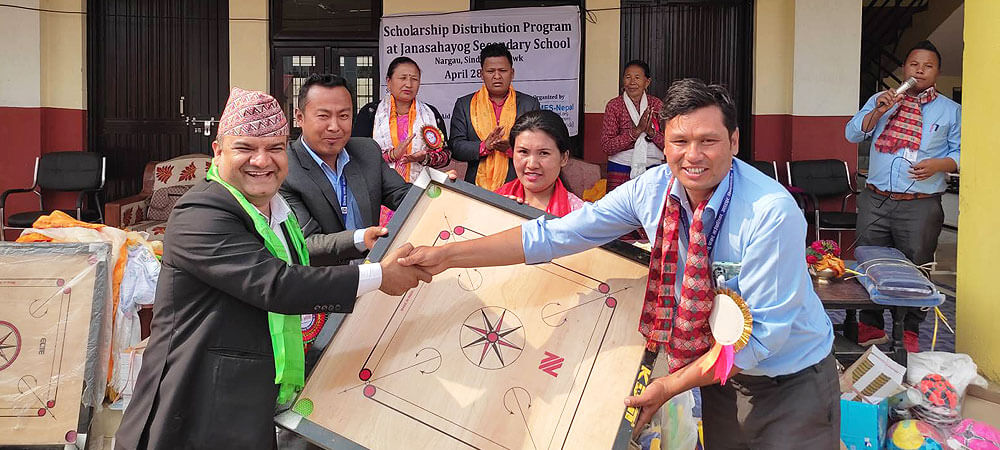HEALTH CAMP REPORT 2022
Title
Report
on
Health Camp Completion
Nargau, Sindhupalchowk and Kagatigau, Nuwakot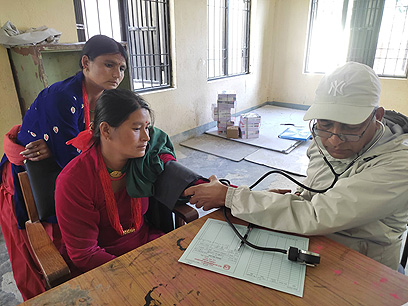
Submitted to:
Juerg Lichtenegger
Switzerland
Prepared by:
HOMES Nepal
Balaju, Kathmandu
Phone: +977-9851036568
Email:
Web: www.homesnepal.org
November, 2022
Background
BACKGROUND OF THE ORGANIZATION
HOMES Nepal is a non-profit and non-governmental organization established in 2007 with the motto to support the downtrodden and vulnerable Nepalese community in Education, Health and Environment. HOMES Nepal, which was legitimately registered with Social Welfare Council (Regd. No. 22540), is affiliated with the Federation of NGOs too. In this locality HOMES Nepal is an-efficient NGO whose active members include Development experts, Researchers, Teachers, Business Entrepreneurs, Tourism and Volunteers and experienced persons. Professionals and Technicians are also involved towards effective and smooth functioning of this Organization.
The health service situation of Nepal is not accessible to all the Nepalese community. So, different NGOs and health service provider are providing the health service to these communities. Likewise, HOMES, Nepal has been conducting the many health and medical camps in different rural areas of Nepal. More than 3000 poor people were already benefited due to these activities.
The activities of HOMES-Nepal cover a broad remit including work to support, education, environmental conservation, health, sanitation, and skill development. Our work is targeted at the poorest communities and in certain cases specifically supports, women, children, orphans, lower castes, the homeless and other marginalized and disempowered peoples within Nepal.
INTRODUCTION OF THE HEALTH CAMP PROJECT
The health service situation of Nepal is not accessible to all the Nepalese community. So, different NGOs and health service provider are providing the health service to these communities. Likewise, HOMES, Nepal has been conducting the many health and medical camps in different rural areas of Nepal. More than 3000 poor people were already benefited due to these activities.
- There are not enoughhospitals, health posts and health centres specially in the remote areas.
- Medical treatment andfacilities are not available as required.
- Doctors and healthworkers hesitate to go to remote areas.
- Rural people mostly rely on witch doctors or Dhami-Jhankri.
- People in remote and rural areasthemselves are less interested to get treatment in hospitals or health posts.
- Private hospitals in urban areas are too expensive for common people. Government hospitals are not well-equipped and service oriented.
INTRODUCTION OF THE HEALTH CAMP PROJECT SITES
1. KAGATI GAU, NUWAKOT
Kagati Gau (Village) is one of the primitive villages of the Nepal where most of the Balami Caste (ethnic group of Newar) are living and continuing their lives. Other castes like Dalits (so called untouchable caste), Chhetri and Brahmin caste are minimum numbers. It is located in the north side of Kathmandu Valley and almost 20 KM far from it. Even though the village is near to the Kathmandu, but it is back warded socially, economically and technologically. The village people is trying to growing up to assimilate the technologically, economically but the tremor earth quake in 2015, also push backed them to the original condition.
The village “Kagati Gau” is famous for the early childhood marriage, the early child marry the old man and give birth in child age as well. They have the huge age difference and bad cultural norms, the women become widow in their early age in between 18-40. The widow women have to bear lots of responsibilities towards family members and their children, so their body structure seems to be old like 60 above when they are 35-40. Due to economically and socially backwarded, they live in the vulnerable condition and not have any opportunities in further progress. Their children are not going school but some of children are going school with minimum facility run by the government.
Widowhood in Nepal is highly stigmatized and therefore is a sensitive topic. Due to discomfort or stigmatization, many women concealed their status as widows in the community through behaviours impacting their daily lives. Concealment of widowhood is a coping strategy Nepali women use to shield themselves against societal stigma and to manage bereavement in their children. Efforts are needed to support widows by livelihood program and in dealing with mental health issues related to the psychosocial impact on their children. There are more than 200 widows who are living in the vulnerable conditions.
After pandemic of COVID-19, the widows and her families are badly suffered from economic income and investment. They even could not able to petty investment to their farm and children. Children are suffering from malnutrition and not wearing clean clothes.
Due to the global pandemic COVID-19, the people of this area also become vulnerable and their economic and health status is being decreased. Health conditions of the people decreased and still they are restoring the normal condition. After Corona, Dengue virus is widely spreading all over the Nepal like epidemic. Almost of the village people are affected by this virus and some of people were died due to low immunity. Moreover, the women of this area are also affected by the uterus prolapses/uterus problems.
After realizing the health situation of these area, HOMES Nepal decided to conduct free health checkup camp and medicine distribution to support and improve the health condition of these areas, and the project was completed.
2. NARGAU, SINDHUPALCHOWK
The area “Nargau” is the dwellings of the ethnic group (Tamang community) who are isolated from other community. The development practices show that those areas where single ethnic group is living, is underdeveloped in all prospective even though it is periphery of the developed city. Nargau is the Historical and Religious place which is situated in the base of the Lisankhu Hill. It lies in the Lisankhu Pakhar Rural Municipality, Sindhupalchowk district of Nepal.
Sindhupalchowk District is a part of Bagmati province and one of the seventy-seven districts of Nepal, with an area of 2,542 km2 (981 sq mi). People depend entirely on agriculture for their survival. Since the district is hilly, the land is not very fertile land, and the yield is very low. So, the lifestyle of people is not easy.
Sindhupalchok is one of the worst-affected districts as a result of the earthquake that took place on 2015. More than 4000 people were killed and many injured. More than 80000 thousand houses are severely damaged and many schools. Almost all houses were damaged by the earthquake of 2015 and not properly reconstructed until to-day due to poverty. They are still living in transitional or temporary home. Due to the poverty, the children are suffering from malnutrition and the school enrollment rate is less. Drop out of kids also affecting the education of this area and most of the kids started the job/labour work in cities or in the construction or transport sector.
Due to the global pandemic COVID-19, the people of this area also become vulnerable and their economic status is being decreased. Health conditions of the people decreased and still they are restoring the normal condition. After Corona, Dengue virus is widely spreading all over the Nepal like epidemic. Almost of the village people are affected by this virus and some of people were died due to low immunity. Moreover, the women of this area are also affected by the uterus prolapses/uterus problems.
After realizing the health situation of these area, HOMES Nepal decided to conduct free health checkup camp and medicine distribution to support and improve the health condition of these areas, and the project was completed.
Objectives
OJECTIVE OF THE PROJECTS
The followings were the main objectives of the project:
- To provide efficient medical team.
- To find out the most prevalence diseases.
- To supply the sufficient medicines and cure the diseases.
- To support the community in social and medical aspects.
- To encourage to visit health center when they have medical problems instead of traditional healers (Dhami, Jhakri).
ACTIVITIES
- Survey and observation
- Homes Nepal team had surveyed the area “Kagatigau and Nargau” and find out health and social status of feeding areas.
- Medicine Purchase
- Homes Nepal had bought medicines with close cooperation of doctors and pharmacists. The medicines were bought with the relevant diseases of the camp project sites.
- Health Checkup and Medicine Distribution
- The organization had provided sufficient medical team in health camp service. All the medical team was actively involved throughout the day during the health camp service and provided medicine free of cost.
- Organizational Support
- The organization had provided volunteers, Nurses, Health Assistants, Pharmacists and doctors to support the patients. All team were actively involved to make systematic queuing and manage quick service to old aged people and children. The volunteers' team was actively involved to carry the disable people from house to health camp service point.
Beneficiaries
BENEFICIARIES IN THE HEALTH CAMP
The dwellings of the Kagati Gau and Nargau were the real beneficiaries of the free health camp and medicine distribution. 611 patients in total were benefited in the camp from different areas.
KAGATI GAU, NUWAKOT
Venue: Shree Bhawani Secondary School
Date: 10-12 November, 2022
Total Patients: 337
| Patients by Sex Ratio | |
| Male | 131 |
| Female | 206 |
| Total | 337 |
| Patients by Age Group | |||
| S.No. | Age | No. of Patients | Remarks |
| 1 | Infant to 10 Years | 26 | |
| 2 | 10 - 20 | 22 | |
| 3 | 20 - 30 | 12 | |
| 4 | 30 - 40 | 31 | |
| 5 | 40 - 50 | 55 | |
| 6 | 50 - 60 | 61 | |
| 7 | 60 - 70 | 66 | |
| 8 | 70 - 80 | 43 | |
| 9 | 80 and above | 21 | |
| Total | 337 | ||
NAR GAU, SINDHUPALCHOWK
Venue: Shree Jansahayog Secondary School
Date: 10-12 November, 2022
Total Patients: 274
| Patients by Sex Ratio | |
| Male | 125 |
| Female | 149 |
| Total | 274 |
| Patients by Age Group | |||
| S.No. | Age | No. of Patients | Remarks |
| 1 | Infant to 10 Years | 23 | |
| 2 | 10 - 20 | 37 | |
| 3 | 20 - 30 | 13 | |
| 4 | 30 - 40 | 26 | |
| 5 | 40 - 50 | 31 | |
| 6 | 50 - 60 | 42 | |
| 7 | 60 - 70 | 50 | |
| 8 | 70 - 80 | 41 | |
| 9 | 80 and above | 11 | |
| Total | 274 | ||
BUDGET UTILIZATION
| S.No. | Activities | Nos | Days | Rate | Total (NRs.) | Remarks |
| A | Health Personnel | |||||
| 1 | Doctors | 8 | 6 | 6000 | 288000 | |
| 2 | Nurses | 4 | 6 | 4000 | 96000 | |
| 3 | Pharmacist | 4 | 6 | 4000 | 96000 | |
| 4 | Health Assistance | 2 | 6 | 4000 | 48000 | |
| 5 | Local Health Volunteers | 11 | 6 | 1000 | 66000 | |
| Total of A | 594000 | |||||
| B | Medicine | |||||
| 1 | Medicine | LS | 695322 | |||
| 2 | Medical Equipment | LS | 189325 | |||
| Total of B | 884647 | |||||
| C | Transportation and Food | |||||
| 1 | Transportation for medical team | LS | 179831 | |||
| 2 | Lodging and Fooding | LS | 160342 | |||
| Total of C | 340173 | |||||
| Total of A+B+C | 1818820 | |||||
| Total Budget Received | 1821040 | |||||
| Balance | 2220 |
Major Achievements
MAJOR ACHIEVEMENTS OF THE PROJECT
The followings are the major output:
- The stigma of traditional healing system (Dhami, Jhakri) has broken due to easy access of medical support
- Diagnosis of major diseases like Knee Joint Problems (Osteoarthritis), Eyes Problems (Cataract and other ocular problems), chronic obstructive pulmonary disease (COPD), CSOM, Dengue Fever, uterus prolapses, and support the people.
- Most of the old aged people (60-90 years) and children were received service which are more ignorance part of community health.
- Enough medical distribution of medicines.
- Exploration of Nepalese health status to the International level
IMPACTS OF THE PROJECT
In the respective areas of Kagati gau and Nargau, there are sub health post for the treatment but due to the lack of medicines and doctors, they have to go Kathmandu for the simple and major health treatment which is more expensive. Most of the people are engaged in subsistence level farming and they do not have surplus money to take care of the health. Due to this reason, they have to hide or ignore their health problems and they are encouraged to depend on Traditional Healing system for the treatment instead to visit health centers. The project tries to break the superstitious believes towards this systems and attended the medical checkup camp.
The project encourages the local people to unite together for the social work.
LIMITATION OF THE PROJECT
The health camp was conducted for the general health where the people are not concerned and unable to reach health centers. The project was concentrated for the general medical health checkup and medicine distribution. It could not cover the surgical services like Eye operation of night blindness, uterus prolapsed and other surgical items. But it covered the dressing of wounds, injections, supply of IV solutions etc.
RECOMMENDATIONS
The care that we provided were basic level, it is recommended that the responsible organization should look forward to provide some specialty care (eye camps) and provision of treatment for some treatable conditions (e.g. chronic superlative otitis media) that could be highly rewarding. They could offer people with free treatment for some conditions e.g. sponsoring eye surgery, ear surgery in co-ordination with other institutions and organizations.
Thank you
Photographs
| Some photographs during Health Camp-Kagati Gau, Nuwakot | |
|
|
|
|
|
|
|
|
|
|
|
|
|
|
|
|
|
|
|
|
|
|
|
|
|
|
|
|
|
|
|
|
|
|
|
|
| Some photographs during Health Camp-Nar Gau, Sindhupalchowk | |
|
|
|
|
|
|
|
|
|
|
|
|
|
|
|
|
|
|
|
|
|
|
|
|
|
|
|
|
|
|
|
|
|
|
|
|


